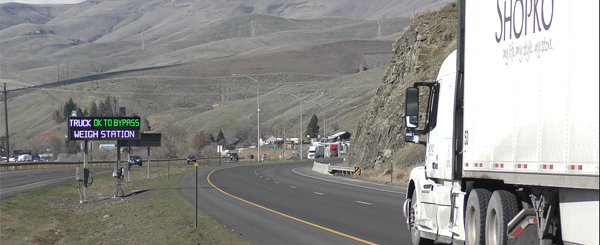Drivers traveling in the Lewiston area in the last month may have noticed some new signs near the Port of Entry along US-95. The signs are the most visible indication of significant money and time savings for commercial drivers.
The new signs are part of an updated system designed to improve the mobility of freight in the area, save time on the road, safeguard taxpayer money and support economic opportunity in the region. Signs are now used to signal commercial rigs to bypass the port if the truck’s weight, height, length, safety rating and credentials are in adherence with the law.
Highway sensors verify the criteria above prior to trucks reaching the port so that flashing signs can alert drivers if they may continue or need to stop.
Recent improvements cost $750,000 but are expected to save much more.
The updated weigh-in-motion system is expected to allow up to 70 percent of commercial traffic heading out of the city and another 50 percent heading into the city to bypass the port just south of town.
Trucks that can bypass a port save an average of five minutes of time per incident and almost a half a gallon of fuel. This amounts to a savings of about $8.68 per bypass, according to an analysis of these systems by the Federal Motor Carrier Safety Administration.
Approximately 800 commercial trucks access the Lewiston area every day, meaning improvements at this port alone will save the trucking industry more than $900,000 this year.
Last year, commercial trucks using similar systems to bypass four Idaho ports saved the trucking industry $3.475 million.
“This technology saves our commercial drivers significant time and money, especially for local drivers who pass through the port three to four times on a normal day,” said Ron Morgan, the supervisor of the Lewiston ports.
Vehicles that bypass also benefit the state and other drivers by reducing congestion around weigh stations and enabling inspectors to focus their efforts on other carriers.
“The recent updates to the system reflect the department’s commitment to building a transportation system that supports economic opportunity and mobility in the area,” Morgan said.

